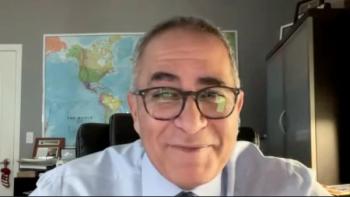
Oncology NEWS International
- Oncology NEWS International Vol 9 No 2
- Volume 9
- Issue 2
Rituximab Active in Multiple Myeloma
BOSTON-Multiple myeloma remains one of the more intractable problems in oncology. Although about 60% of patients respond to current standard treatment with melphalan and prednisone, median survival is only 2 to 3 years, and toxicity is significant. Nearly all multiple myeloma patients treated with melphalan/prednisone ultimately die of progressive disease. About 25% of patients survive for 5 years or longer, but 10-year survival is less than 5%. High-dose chemotherapy followed by stem-cell transplantation produces higher remission rates but no cures.
BOSTON-Multiple myeloma remains one of the more intractable problems in oncology. Although about 60% of patients respond to current standard treatment with melphalan and prednisone, median survival is only 2 to 3 years, and toxicity is significant. Nearly all multiple myeloma patients treated with melphalan/prednisone ultimately die of progressive disease. About 25% of patients survive for 5 years or longer, but 10-year survival is less than 5%. High-dose chemotherapy followed by stem-cell transplantation produces higher remission rates but no cures.
Immune-based approaches are being explored in attempts to induce or prolong remissions in multiple myeloma. Interim data from a Phase II trial presented at the ASH meeting suggest that monoclonal antibody therapy directed against the CD20 antigen may be useful.
Single Agent Study
A study reported by Steven P. Treon, MD, PhD, and colleagues from the Dana-Farber Cancer Institute showed that 6 of 15 evaluable multiple myeloma patients treated with rituximab (Rituxan) had either a partial response (1 patient) or stable disease (5 patients) following treatment. Mean time to treatment failure in these responders was 5.7 months (range 3 to 13+ months).
The CD20 antigen is one of the relatively few surface antigens on plasma cells that are suitable for antibody-directed immunotherapy (see Table 1). There is evidence suggesting that B cells and plasma cells are members of the malignant clone in multiple myeloma.
“Circulating CD20+ B cells bearing IgH rearrangements identical to those in autologous plasma cells circulate in most multiple myeloma patients,” Dr. Treon said. “In addition, plasma cells from about 20% of multiple myeloma patients express CD20. In view of these data, a Phase II trial using single agent rituximab was initiated.” This ongoing trial has enrolled 18 patients with a mean age of 60.2 years (range 36 to 88 years).
The mean number of prior therapies was 3.5 (range 1 to 6). Patients receive 1 cycle of rituximab (375 mg/m² IV weekly x 4) and are reassessed at 12 weeks. Patients with stable disease or a partial response receive a second course of rituximab, and those achieving a complete response are observed and treated on recurrence.
Measuring CD20 Expression
To examine the relationship between response and CD20 expression, flow cytometry was used to measure CD20 expression on bone marrow and peripheral blood B cells and plasma cells before and after rituximab treatment. This showed that circulating B cells were CD20+ in all patients treated so far. Six of 18 patients expressed CD20 on bone marrow plasma cells ranging from dim to bright expression, and for some expression was heterogeneous with both CD20 negative and positive cells present.
“The one partial response occurred in a patient who had mostly (68%) CD20+ bone marrow plasma cells, and one patient who had CD20- bone marrow plasma cells remains with stable disease at over 13 months,” Dr. Treon said. Four of five patients who had partial response or stable disease in this study in whom CD20 status could be determined were CD20+. CD20 status was indeterminate for one patient in this study group, Dr. Treon added.
Study Is Continuing
This suggests that patients with CD20+ bone marrow plasma cells may be more likely to benefit from rituximab treatment. Interferon-gamma treatment used in conjunction with rituximab might be a way to increase treatment efficacy, Dr. Treon said, since it induces CD20 expression on multiple myeloma plasma cells and leads to augmented binding of rituximab.
Rituximab was well tolerated in these patients. Dr. Treon said that one patient developed moderate hemoptysis after one cycle of rituximab. A detailed workup including bronchoscopy was unrevealing, and the hemoptysis resolved without treatment.
“These studies provide the first report of response in a multiple myeloma patient treated with serotherapy directed at CD20,” Dr. Treon concluded. The study is continuing to accrue patients and to evaluate responses.
Articles in this issue
almost 26 years ago
Neoadjuvant Docetaxel Increases Response Rate in Large Breast Tumorsalmost 26 years ago
Faslodex, a Pure Antiestrogen, Shows Antitumor Activityalmost 26 years ago
Consider Node Dissection, Adjuvant Therapy in Elderly Breast Cancer Patientsalmost 26 years ago
Tumor-Associated Proteases Predict Outcome in Node-Negative Patientsalmost 26 years ago
Herceptin Plus Vinorelbine a Promising Combination in Advanced Breast Canceralmost 26 years ago
Small Risk of Breast Cancer Death After Invasive Recurrence in DCIS Patientsalmost 26 years ago
Paclitaxel/Herceptin Effective in Metastatic Breast Canceralmost 26 years ago
Conservative Surgery Alone Not Sufficient to Prevent RecurrenceNewsletter
Stay up to date on recent advances in the multidisciplinary approach to cancer.


![“[This approval] will be a quite dramatic change in our philosophy and practice in multiple myeloma," according to Joseph Mikhael, MD, MEd, FRCPC, FACP, FASCO.](https://cdn.sanity.io/images/0vv8moc6/cancernetwork/3cab3ada4c023b68c118240a512e31d72a7f931b-1200x628.png?w=350&fit=crop&auto=format)

















































































